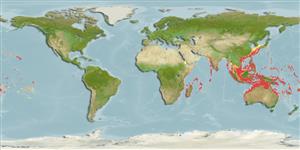Common names from other countries
>
Eupercaria/misc (Various families in series Eupercaria) >
Lethrinidae (Emperors or scavengers) > Lethrininae
Etymology: Lethrinus: Greek, lethrinia, a fish pertaining to genus Pagellus.
Environment: milieu / climate zone / depth range / distribution range
Ecologie
marien rifbewoner; standvastig; diepte 10 - 198 m (Ref. 86942). Tropical; 38°N - 31°S, 30°E - 139°W
Indo-Pacific: East Africa to south Korea in the Yellow Sea, and the Marquesas Islands.
Lengte bij maturiteit / Grootte / Gewicht / Leeftijd
Maturity: Lm 23.0, range 20 - 26 cm
Max length : 57.0 cm FL mannelijk / geslacht onbekend; (Ref. 125599); common length : 30.0 cm TL mannelijk / geslacht onbekend; (Ref. 2295); max. gepubliceerd gewicht: 3.1 kg (Ref. 125599)
Dorsale stekels (totaal) : 10; Dorsale zachte stralen (totaal) : 9; Anale stekels: 3; Anale zachte stralen: 8. This species is distinguished by the following characters: body moderately elongate, its depth 3-3.4 times in standard length; head length 1.1-1.3 times in body depth, 2.6-3 times in SL, dorsal profile near eye convex without a distinct hump; snout length 1.8-2.1 times in HL, measured without the lip the snout is 0.7-0.9 times in cheek height, its dorsal profile nearly straight or slightly concave, snout angle relative to upper jaw between 54° and 65°; interorbital space flat or slightly convex; posterior nostril a longitudinal oblong opening, closer to orbit than anterior nostril; eye situated close or slightly removed from dorsal profile, its length 3.9-4.7 times in HL; cheek height 2.4-3.3 times in HL; lateral teeth in jaws conical; outer surface of maxilla smooth or with a longitudinal ridge; D X,9 with the 3rd dorsal-fin spine the longest, its length 2.4-2.7 times in body depth; A III,8 with the first soft ray usually the longest, its length shorter than length of base of soft-rayed portion of anal fin and 1.4-1.8 times in length of entire anal-fin base; pectoral-fin rays 13; pelvic-fin membranes between rays closest to body without dense melanophores; cheek without scales; 47-49 lateral-line scales; 4 ½ scale rows between lateral line and base of middle dorsal-fin spines; 15-16 scale rows in transverse series between origin of anal fin and lateral line; usually 15 rows in lower series of scales around caudal peduncle; 7-10 scales in supratemporal patch; inner surface of pectoral-fin base without scales; posterior angle of operculum with a wide scaleless area. Colour of body olive grey or brown, with scattered irregular small black blotches; lips and a spot on upper edge of operculum usually red; fins pale or pinkish (Ref. 114226).
Found over sand and rubble areas of outer reef slopes (Ref. 30573). Feeds mainly on crustaceans, fish, echinoderms and mollusks (Ref. 30573). In New Caledonia, spawning peaks are observed in December and a fairly high percentage of gonads in advanced stages of maturity occurs between October and February (Ref. 9775). Caught mostly by handline, trap, and trawl. Marketed mostly fresh. An excellent food fish (Ref. 114226).
Levenscyclus en paargedrag
Maturities | Voortplanting | Spawnings | Egg(s) | Fecundities | Larven
Oviparous (Ref. 205). Also Ref. 103751.
Carpenter, K.E. and G.R. Allen, 1989. FAO Species Catalogue. Vol. 9. Emperor fishes and large-eye breams of the world (family Lethrinidae). An annotated and illustrated catalogue of lethrinid species known to date. FAO Fish. Synop. 125(9):118 p. Rome: FAO. (Ref. 2295)
Status op de Rode Lijst van het IUCN (Ref. 130435)
CITES (Ref. 128078)
Not Evaluated
Gevaar voor de mens
Harmless
Gebruik door de mens
Visserij: van groot commercieel belang
Tools
Speciale rapporten
Download XML
Internetbronnen
Estimates based on models
Preferred temperature (Ref.
115969): 22.4 - 28.3, mean 26.9 (based on 844 cells).
Fylogenetische diversiteitsindex (Ref.
82804): PD
50 = 0.5000 [Uniqueness, from 0.5 = low to 2.0 = high].
Bayesian length-weight: a=0.01445 (0.01230 - 0.01698), b=2.97 (2.93 - 3.01), in cm Total Length, based on LWR estimates for this species (Ref.
93245).
Trofisch niveau (Ref.
69278): 3.8 ±0.0 se; based on diet studies.
Weerstandsvermogen (Ref.
120179): Gemiddeld, minimale populatieverdubbelingstijd 1,4-4,4 jaar (Preliminary K or Fecundity.).
Fishing Vulnerability (Ref.
59153): Low to moderate vulnerability (33 of 100).
